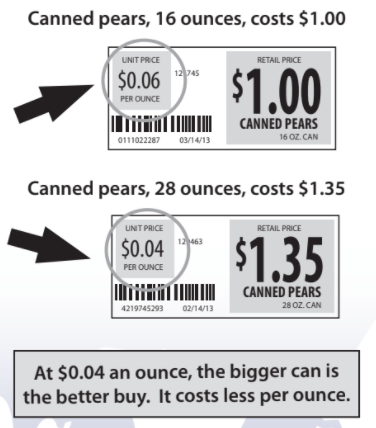Many families worry about the cost of food but it is possible to serve healthy and delicious meals on a budget. One way to stretch our food dollars is by comparing unit pricing while we shop.
The unit price label tells you the cost of the item per ounce or pound. In most stores, the unit price of a food item is shown on a sticker on the grocery store shelf below each item. You can use this information to compare the price of a similar item in different sizes or brands.
Let’s look at an example which compares 2 cans of pears. You can see that the cans are different sizes:
Canned pears, 16 ounces, costs $1.00
Canned pears, 28 ounces, costs $1.35 (That’s TWICE the amount of pears for only .35 cents more!)
Notice that the 28 ounce can costs more, but you are getting twice the amount of pears for just a little more money. If you purchase two of the 16 ounce cans, you would pay $2.00 compared to the $1.35 you would pay for buying the 28 ounce can. By purchasing the larger can, you will save 65 cents.

Here are some other ways to save money while shopping:
Tip – Buy only the items your family will use. Large-size items at a low price are only a bargain if you will use them before they spoil.
Tip – Larger cans/packages can be opened and moved and stored in smaller containers/bags. Store unused portions in a container with a sealed lid in the refrigerator for up to 7 days. You can also freeze the food in a freezer bag (for up to 3 months) to use at a later time.
Use these tips to save money with the following items:
- Canned tomatoes and tomatoes sauce
- Canned fruit
- Canned vegetables
- Fresh foods such as meat, fish and vegetables
Try this delicious Fruit Salad recipe. Remember, if you purchase the fruit in larger cans, use what you need and refrigerate or freeze the rest for use at another time.
For other tips on making the most of your food dollars, check out these ideas: Eat Right when Money is Tight.
